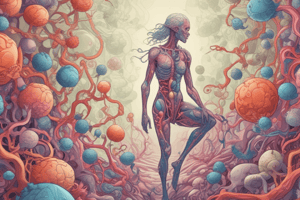Podcast
Questions and Answers
What is the primary focus of human anatomy?
What is the primary focus of human anatomy?
- Analyzing the environment's impact on living organisms
- Studying the interactions of living organisms
- Exploring the structure and function of the human body (correct)
- Investigating the chemical composition of cells
What is the main difference between prokaryotic and eukaryotic cells?
What is the main difference between prokaryotic and eukaryotic cells?
- Eukaryotic cells have a nucleus but no organelles
- Prokaryotic cells have a nucleus and organelles
- Eukaryotic cells lack a nucleus and organelles
- Prokaryotic cells lack a nucleus and organelles (correct)
How are anatomical structures classified based on organization levels?
How are anatomical structures classified based on organization levels?
- Organs, organelles, cells, tissues (correct)
- Cells, tissues, organs, organ systems
- Genes, chromosomes, cells, tissues
- Tissues, cells, organs, organelles
Which statement accurately describes the role of cells in living organisms?
Which statement accurately describes the role of cells in living organisms?
How are eukaryotic cells different from prokaryotic cells in terms of structure?
How are eukaryotic cells different from prokaryotic cells in terms of structure?
What is the significance of understanding human anatomy according to the text?
What is the significance of understanding human anatomy according to the text?
Which type of tissue is responsible for transmitting electrical signals in the body?
Which type of tissue is responsible for transmitting electrical signals in the body?
What is the primary function of the circulatory system?
What is the primary function of the circulatory system?
Which organelle is known as the 'powerhouse' of the cell due to its role in energy production?
Which organelle is known as the 'powerhouse' of the cell due to its role in energy production?
What is the main function of epithelial tissue in the human body?
What is the main function of epithelial tissue in the human body?
Which type of organ is responsible for detoxifying chemicals and metabolizing drugs?
Which type of organ is responsible for detoxifying chemicals and metabolizing drugs?
In which organ system would you find the pancreas, an organ crucial for regulating blood sugar levels?
In which organ system would you find the pancreas, an organ crucial for regulating blood sugar levels?
Flashcards are hidden until you start studying
Study Notes
Understanding the Human Body: An In-depth Look into the Subtopics of Human Anatomy
Introduction
Biology, as a discipline, encompasses the study of all living organisms and their interactions with their environments. One of the most fascinating areas within biology is human anatomy, which focuses on the structure and function of the human body. Understanding the human body's intricate systems and components is essential for understanding life itself. In this article, we will delve into the subtopics of human anatomy, shedding light on the various aspects of this intriguing subject.
Anatomy: The Study of Body Structure
Anatomy is the branch of biology that deals with the study of the structure of body parts and their organization within the human body. It is a crucial aspect of understanding the function of different systems in the body. Anatomical structures can be classified into various levels of organization, including organs, organ systems, tissues, organelles, and cells.
Cells: The Building Blocks of Life
Cells are the fundamental unit of life, serving as the building blocks for all living organisms. Humans are composed of trillions of cells, which can be categorized into two main types: prokaryotic and eukaryotic. Prokaryotic cells lack a nucleus and other membrane-bound organelles, while eukaryotic cells, such as those found in humans, have a nucleus and various organelles that perform specific functions.
Tissues: Groupings of Similar Cells
Tissues are groups of similar cells that work together to perform a specific function within the body. There are four main types of tissues in humans: epithelial, connective, muscle, and nervous. Each type of tissue plays a unique role in maintaining the body's structure and functions.
Organs: Complex Structures with Specific Functions
Organs are complex structures made up of various tissues that work together to perform specific tasks within the body. Examples of organs include the heart, lungs, liver, and kidneys. Each organ is responsible for a particular function, such as circulating blood, extracting waste, or converting food into energy.
Organ Systems: Higher Levels of Organization
Organ systems are groups of functionally related organs that work together to perform a specific task or maintain a particular aspect of homeostasis. For example, the circulatory system is responsible for transporting blood throughout the body, while the nervous system coordinates the body's responses to various stimuli.
Organelles: Membrane-Bound Compartments within Cells
Organelles are membrane-bound compartments within cells that perform specific functions. Examples of organelles include the nucleus, mitochondria, and endoplasmic reticulum. These structures are essential for maintaining the health and function of cells.
Conclusion
Understanding the subtopics of human anatomy is essential for comprehending the structure and function of the human body. The study of anatomy provides valuable insights into the intricate systems and components that make up our bodies, allowing us to appreciate the complexity and beauty of life.
Studying That Suits You
Use AI to generate personalized quizzes and flashcards to suit your learning preferences.




